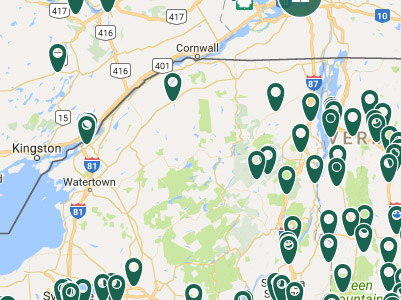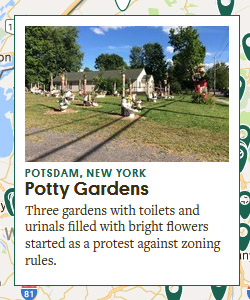North Country Obscura
When you live in small places off the beaten track you can be forgiven a certain defensiveness, particularly when representatives of the wider world zero in on local living.
Remember when NYC mayor Ed Koch ran for governor in 1982? Asked about the amount of time a city resident wastes waiting for a late subway, he responded: “As opposed to wasting time in a car? Or a pickup truck when you have to drive 20 miles to buy a gingham dress or a Sears Roebuck suit?” Ouch! Remember Gov. Koch? That’s right, you don’t, because he only got about four votes north of the Thruway. But I digress.
Anyway, it was with some trepidation that I spotted a Facebook share Ellen Rocco made a few days ago from Atlas Obscura, a site I normally enjoy exploring for its interesting maps and travel features. It was “The Definitive Map of the World’s Most Strange and Wonderful Places.” Once I saw that there were hundreds of selections in the Northeast U.S., I had to find out how the world’s amateur globetrotters saw the North Country. Masochism, I suppose.
It contained some standard tourist destinations like Boldt Castle in the Thousand Islands and Ausable Chasm in Keeseville, cultural venues like the Marcella Sembrich Opera Museum in Bolton, and hiking mainstays like Mt. Marcy in Keene and nearby Lake Tear of the Clouds, source of the Hudson River.
And it contained some of the oddities that are the hallmark of Atlas Obscura: The Atlas Missile Silo Home in Saranac, Zavikon Island (one of the Thousand), home to the world’s shortest international bridge connected a Canadian camp with its backyard in the U.S., and a new one to me – The Lake George Mystery Spot – a precise location behind the Visitor’s Center where you (and only you) can hear a distorted echo of your voice.
But it also mustered some mean girl energy to describe the Deer Island retreat of Yale’s Skull and Bones Society as “kind of a dump,” and managed to stop at both the abandoned and derelict theme park Frontier Town in Schroon and the abandoned and derelict mining town of Tahawus in Newcomb. Am I sensing a theme here, or just being sensitive?
No, because when I saw that the only map pin in St. Lawrence County was on my own hometown of Potsdam, I knew it would not be Potsdam, home of the inventor of the milk bottle, or Potsdam, site of many landmark buildings made of lovely and unique red sandstone, or Potsdam, home of music education pioneer Julia Crane. It would be – and is – Potsdam, home of the Potty Gardens. Sigh! I was hoping they could remain a little more obscure.
Tags: listeningpost









